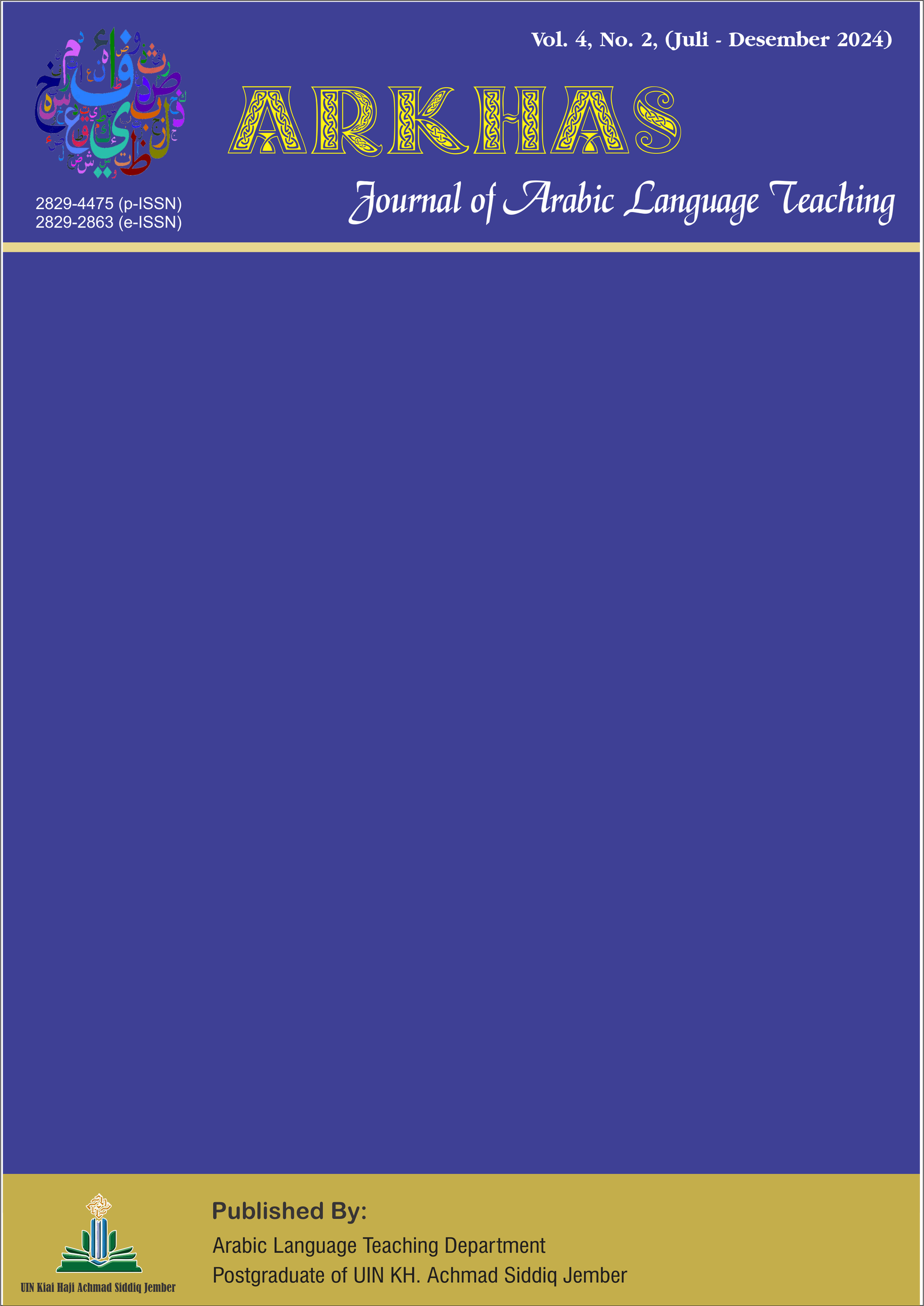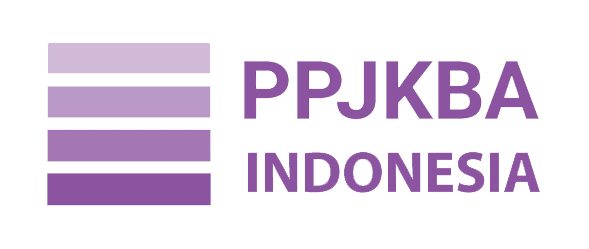Arabic Language as a Catalyst for Effective Learning of Islamic Studies in Western-Oriented Schools in Nigeria
DOI:
https://doi.org/10.35719/arkhas.v5i2.2255Keywords:
Arabic, Catalyst, Manuscript, Learning, Islamic StudiesAbstract
Arabic is crucial for a deep understanding of Islamic Studies, particularly in Western-oriented schools in Nigeria. Although its importance is acknowledged, there is a gap in empirical research on the extent to which Arabic serves as a catalyst for improving students' academic achievement. This study investigates the role of Arabic as a catalyst for effective learning of Islamic Studies and its significant relationship with academic performance. The research uses a descriptive survey method. Data were collected through questionnaires in Nigerian schools and analyzed statistically to identify correlations between variables. The findings show a significant positive relationship between knowledge of Arabic and understanding of Islamic Studies. Knowledge of Nahwu (syntax) and Sharaf (morphology) facilitates comprehension of primary texts, which enhances students' academic performance. Arabic is an essential prerequisite for effective learning of Islamic Studies. The study recommends integrating Arabic into the Islamic Studies curriculum starting from the secondary school level.
References
Abdalla, M. (2025). Exploring Tarbiyah in Islamic Education: A Critical Review of the English- and Arabic-Language Literature. Education Sciences, 15(5), 559. https://doi.org/10.3390/educsci15050559
Adamu, A. I., & Ardo, H. (2025). Modern Centers of Qur’anic Recitation and its Positive Effects on Students and the Society in Yobe State. LECTURES: Journal of Islamic and Education Studies, 4(1), 25–37. https://doi.org/10.58355/lectures.v4i1.122
Adi, H. M. M., & Adi, N. R. M. (2022). Pembelajaran Naḥwu-Ṣarf di Pesantren dengan Pendekatan Interpretatif: Implikasi Teori Interpretasi Jorge JE Gracia dalam Pembelajaran Kitab Alfiyyah Ibn Mālik. In Alibbaa’: Jurnal Pendidikan Bahasa Arab (Vol. 3, Issue 1, pp. 20–37). Institut Agama Islam Negeri Madura. https://doi.org/10.19105/ajpba.v3i1.5474
Adiyono, A., Ni’am, S., & Akhyak, A. (2024). Methodology of Islamic Studies: Islam as Religion (A Perspective Epistemology, Paradigm, and Methodology). Analisis: Jurnal Studi Keislaman, 24(1), 169–200. https://doi.org/10.24042/ajsk.v24i1.22636
Al Shlowiy, A. S. (2022). Language, religion, and communication. Journal of Asian Pacific Communication, 32(2), 198–213. https://doi.org/10.1075/japc.00040.shl
Alfiyah, N., Zuhriyah, I. A., & Chalishah, N. D. (2025). Validity and Reliability Analysis: Measuring the Accuracy and Consistency of Instruments for the Evaluation of Islamic Religious Education Tests. JIIP - Jurnal Ilmiah Ilmu Pendidikan, 8(3), 2672–2679. https://doi.org/10.54371/jiip.v8i3.7230
Alkhateeb, H., & Bouherar, S. (2023). Sustainability and educational language policy in Arab higher education: findings from Q research. Current Issues in Language Planning, 24(5), 573–595. https://doi.org/10.1080/14664208.2022.2155925
Ashari, M. Y., Huda, M. M., & ... (2023). Implementation Of Direct Reading Thinking Activity In Learning To Read In Arabic Lessons. Journal of Arabic …. https://jurnalpasca.uinkhas.ac.id/index.php/ARKHAS/article/view/1801
Ayyad, E. (2022). Re-Evaluating Early Memorization of the Qurʾān in Medieval Muslim Cultures. Religions, 13(2). https://doi.org/10.3390/rel13020179
Bano, M. (2022). Curricula that Respond to Local Needs: Analysing Community Support for Islamic and Quranic Schools in Northern Nigeria. https://doi.org/10.35489/BSG-RISE-WP_2022/103
Bhat, A. M., & Bisati, A. A. (2025). Rationality in the Qur’an: Integrating Reason and Revelation for Contemporary Islamic Education. Dirasah International Journal of Islamic Studies, 3(1), 1–17. https://doi.org/10.59373/drs.v3i1.40
Busari Afeez Babatunde, Sarkanto, Eka Mahargiani Rokhma, Mubayinah, & Triana Hermawati. (2025). The structure of madrasa education in nigeria and government initiatives. Jurnal Ilmu Pendidikan Dan Sains Islam Interdisipliner, 99–112. https://doi.org/10.59944/jipsi.v4i3.469
Chen, Y., & Bjerva, J. (2023). Colexifications for Bootstrapping Cross-lingual Datasets: The Case of Phonology, Concreteness, and Affectiveness. In N. G., C. E., C. C., & M. F. (Eds.), Proceedings of the Annual Meeting of the Association for Computational Linguistics (pp. 98–109). Association for Computational Linguistics (ACL). https://www.scopus.com/inward/record.uri?eid=2-s2.0-85175400210&partnerID=40&md5=9146509dce379c7b1427a2d92371b883
Di Blasio, B. (2024). The role of Christian faith in the reintegration of female prisoners. Belügyi Szemle, 72(3), 521–547. https://doi.org/10.38146/bsz-ajia.2024.v72.i3.pp521-547
Donaldson, C. (2020). The Role of Islam, Ajami writings, and educational reform in Sulemaana Kantè’s N’ko. African Studies Review, 63(3), 462–486. https://doi.org/10.1017/asr.2019.59
Echendu, A. J. (2022). Flooding, Food Security and the Sustainable Development Goals in Nigeria: An Assemblage and Systems Thinking Approach. Social Sciences, 11(2), 59. https://doi.org/10.3390/socsci11020059
Fouz Mohamed Zacky, M., & Moniruzzaman, M. (2024). ‘Islamic Epistemology’ in a Modern Context: Anatomy of an Evolving Debate. Social Epistemology, 38(4), 511–525. https://doi.org/10.1080/02691728.2023.2227945
Gonzalez-Dogan, S. (2022). Linguistic Othering and “knowledge deserts”: Perspectives on Arabic use in linguistically diverse Islamic institutions. Linguistics and Education, 71. https://doi.org/10.1016/j.linged.2022.101076
Hakim, M. D., & Sirojudin, D. (2022). Pembelajaran Bahasa Arab berbasis Student-Centered Learning di Universitas KH. A. Wahab Hasbullah Jombang. In Al-Lahjah: Jurnal Pendidikan, Bahasa Arab, dan Kajian Linguistik Arab (Vol. 5, Issue 2, pp. 1–8). Universitas KH. A. Wahab Hasbullah. https://doi.org/10.32764/al-lahjah.v5i2.2647
Horwitz, I. M. (2021). Religion and Academic Achievement: A Research Review Spanning Secondary School and Higher Education. Review of Religious Research, 63(1), 107–154. https://doi.org/10.1007/s13644-020-00433-y
Huda, M. M., Rais, P., Surur, A. M., & Rohmawati, A. (2020). Improvement Of Nahwu And Sharaf Learning Using Amtsilati Method. Ijaz Arabi Journal of Arabic Learning, 3(1). https://doi.org/10.18860/ijazarabi.v3i1.6781
Husnol Khotimah, Manshur, U., Zaini, A. W., Sanjani, M. A. F., & Suhermanto, S. (2024). Increasing The Competence Of Islamic Religious Education Teachers From A Madrasah-Based Management Perspective. Managere: Indonesian Journal of Educational Management, 6(1), 13–26. https://doi.org/10.52627/managere.v6i1.388
Idoko, P. E. (2022). Islamic Religious Education Textbooks in a Pluralist Nigeria. Religions, 14(1), 42. https://doi.org/10.3390/rel14010042
Imamah, Y. H. (2023). Integration of Religious Moderation in Developing an Islamic Religious Education Curriculum. Scaffolding: Jurnal Pendidikan Islam Dan Multikulturalisme, 5(3), 573–589. https://doi.org/10.37680/scaffolding.v5i3.3841
Iwanaga, J., Loukas, M., Dumont, A. S., & Tubbs, R. S. (2021). A review of anatomy education during and after the COVID ‐19 pandemic: Revisiting traditional and modern methods to achieve future innovation. Clinical Anatomy, 34(1), 108–114. https://doi.org/10.1002/ca.23655
Jegede, O. O. (2025). Impact of using students’ first language as medium of instruction on academic performance in elementary public and private schools in Nigeria. Multicultural Learning and Teaching. https://doi.org/10.1515/mlt-2024-0012
Journal, I. M. (2025). Understanding and Mitigating Bias and Noise in Data Collection , Imputation and Analysis. 01(04), 1–29.
Kanaki, K., & Kalogiannakis, M. (2023). Sample design challenges: an educational research paradigm. International Journal of Technology Enhanced Learning, 15(3), 266–285. https://doi.org/10.1504/IJTEL.2023.131865
Khalid, H. M., Fuad, N., Hasan, A., Ahmad, S., & Jalal, H. A. (2023). Tawhidic paradigm elements (TPE) towards balancing the quality of value engineering (VE): A study. 040006. https://doi.org/10.1063/5.0166362
Khasawneh, N., & Khasawneh, M. A. S. (2022). An Analysis of Arabic Language Needs for Speakers of Other Languages at Jordanian Universities. International Journal of Language Education, 6(3), 245. https://doi.org/10.26858/ijole.v6i3.21623
Khoa, B. T., Hung, B. P., & Brahmi, M. H. (2023). Qualitative research in social sciences: data collection, data analysis and report writing. International Journal of Public Sector Performance Management, 12(1/2), 187–209. https://doi.org/10.1504/IJPSPM.2023.132247
Köpeczi-Bócz, T. (2025). Cognitive-Dissonance-Based Educational Methodological Innovation for a Conceptual Change to Increase Institutional Confidence and Learning Motivation. Education Sciences, 15(3), 378. https://doi.org/10.3390/educsci15030378
Majid, A. A., & Aljunied, K. (2023). Some Reflections On The Islamization Of Knowledge. Al-Shajarah: Journal of the International Institute of Islamic Thought and Civilization (ISTAC), 28(2), 407–423. https://doi.org/10.31436/shajarah.v28i2.1721
Mardian, A. S., Villarroel, L., Kemper, L., Quist, H. E., & Hanson, E. R. (2023). Didactic dissonance—embracing the tension between classroom and clinical education. Frontiers in Medicine, 10. https://doi.org/10.3389/fmed.2023.1197373
Mohajeri, K., Mesgari, M., & Lee, A. S. (2020). When Statistical Significance Is Not Enough: Investigating Relevance, Practical Significance, and Statistical Significance. MIS Quarterly, 44(2), 525–560. https://doi.org/10.25300/MISQ/2020/13932
Mohamed, Y., Hoque, M., Ismail, T. H. S. Bin, Ibrahim, M. H., Saad, N. M., & Zaidi, N. N. M. (2021). Relationship Between Phonology, Phonetics, and Tajweed: A Literature Review. Proceedings of the 4th International Conference on Sustainable Innovation 2020–Social, Humanity, and Education (ICoSIHESS 2020). https://doi.org/10.2991/assehr.k.210120.153
Mohammad, A. R. (2024). Intertwining worlds: The dynamics of linguistic religion and religious language. Journal of Religion and Linguistics, 1(2), 49–66. https://doi.org/10.31763/jorel.v1i2.6
Moslimany, R., Otaibi, A., & Shaikh, F. (2024). Designing a holistic curriculum: Challenges and opportunities in islamic education. Journal on Islamic Studies, 1(1), 52–73. https://doi.org/10.35335/beztg009
Muhammad, T., & Al-Shaghdari, F. (2024). Islamic social finance system: an alternative tool for tackling educational setbacks in Northern Nigeria. Journal of Islamic Marketing, 15(11), 3115–3136. https://doi.org/10.1108/JIMA-05-2023-0149
Mukmin, M., Hidayah, N., Haya, A. S., Md Ali, N. J., & Abdullah, A. W. (2025). Determining Arabic Language Proficiency: An Examination of Grammar Mastery, Active Usage, and Discipline of Linguistic. Jurnal Al Bayan: Jurnal Jurusan Pendidikan Bahasa Arab, 17(1), 178–194. https://doi.org/10.24042/5tevdz36
Mulyani, R., Karimullah, Wahab, & Sobirin, S. S. (2024). Characteristics of Islamic religious education assessment instruments. At Turots: Jurnal Pendidikan Islam, 250–258. https://doi.org/10.51468/jpi.v6i1.439
Ogunnaike, O. (2020). Sufism, Islamic Philosophy, and Education in West Africa. In Oxford Research Encyclopedia of African History. Oxford University Press. https://doi.org/10.1093/acrefore/9780190277734.013.592
Onya, O. R., Chukwudi, U. M., Godwin, Akeke, M. N., Okpa, Ovat, E., Ugah, Uguma, V., & Ekpo, A. M. (2023). Exploring education leaders’ perceptions of the effectiveness of socio-religious organisations in higher education funding in Cross River State, Nigeria. Nurture, 18(1), 115–129. https://doi.org/10.55951/nurture.v18i1.547
Oraby, E., & Azaz, M. (2023). Translanguaging Practices in Content-based Instruction in L2 Arabic. Applied Linguistics, 44(6), 947–975. https://doi.org/10.1093/applin/amac054
Pranajaya, S. A., Idris, J., Abidin, Z., & Mahdi. (2023). Integration of Cognitive, Affective, and Psychomotor Domain Scoring in Islamic Religious Education. Sinergi International Journal of Education, 1(2), 95–108. https://doi.org/10.61194/education.v1i2.106
Purwanza, S. W. (2022). Metodologi penelitian kuantitatif, kualitatif dan kombinasi. books.google.com. https://books.google.com/books?hl=en&lr=&id=0CjKEAAAQBAJ&oi=fnd&pg=PA1&dq=metode+penelitian+pendidikan+pendekatan+kuantitatif+kualitatif+dan+r+d&ots=Fyi7bmFifn&sig=D_thwRhnIB7O7pMCWRHhurZzPf4
Rahman, G. (2025). Reconstructing Islamic Identity in Modern Times: A Narrative Review of Educational Reform and Intellectual Responses. Sinergi International Journal of Islamic Studies, 3(1), 29–43. https://doi.org/10.61194/ijis.v3i1.708
Rifky, S., Nasution, M. A. A., Selvia, D. S. E., Isti’ana, A., & Yusnita, E. (2024). Challenges and Opportunities for Islamic Religious Education in a Secular Environment in a Literature Review. Permata : Jurnal Pendidikan Agama Islam, 5(1). https://doi.org/10.47453/permata.v5i1.2004
Salmas, A. N. H., Bahruddin, U., & Syuhadak, S. (2024). Exploring Language Proficiency: Dynamics of Acquiring Arabic Speaking Skills from Stephen Krashen’s Perspective At Islamic Universities. AL-ISHLAH: Jurnal Pendidikan, 16(3). https://doi.org/10.35445/alishlah.v16i3.5100
Sarkingobir, Y., & Bello, A. (2024). Enhancing Critical Thinking through Ethnoscience-Integrated Problem-Based Learning: A Comparative Study in Secondary Education. International Journal of Ethnoscience and Technology in Education, 1(1), 1. https://doi.org/10.33394/ijete.v1i1.10878
Sassi, K. (2021). Principles of Islamic Education Epistemology Tauhid Paradigm (Analysis of Thinking of Naquib Al-Attas). International Journal of Elementary Education, 10(3), 68. https://doi.org/10.11648/j.ijeedu.20211003.14
Siedlecki, S. L. (2020). Understanding descriptive research designs and methods. Clinical Nurse Specialist. https://journals.lww.com/cns-journal/fulltext/2020/01000/understanding_descriptive_research_designs_and.4.aspx
Tamimi Sa’d, S. H. (2019). Examining the dynamics of interaction in an Arab speech community in Iran: A sociolinguistic ethnography. Dialectologia, 23, 213–233. https://www.scopus.com/inward/record.uri?eid=2-s2.0-85077654601&partnerID=40&md5=b9aebddad4ee020ee77cdb7c8238773f
Tom-Lawyer, O., & Thomas, M. (2020). Re-examining the Status of the English Language in Anglophone Western Africa: A Comparative Study of Ghana and Nigeria. English Linguistics Research, 9(4), 6. https://doi.org/10.5430/elr.v9n4p6
Treacy, M., & Leavy, A. (2023). Student voice and its role in creating cognitive dissonance: the neglected narrative in teacher professional development. Professional Development in Education, 49(3), 458–477. https://doi.org/10.1080/19415257.2021.1876147
Veronica, A., Abas, M., Hidayah, N., & ... (2022). Metodologi Penelitian Kuantitatif. In PT. Global Eksekutif …. repository.umi.ac.id. https://repository.umi.ac.id/1989/2/Metodologi Penelitian Kuantitatif.pdf
Yasmadi, Y., Husna, I., Arsya, F., Rahmah, A., Kustati, M., & Perrodin, D. D. (2024). Insights from a State Islamic University on Arabic Education as a Catalyst for Religious Moderation in Indonesia. International Journal of Language Education, 8(3). https://doi.org/10.26858/ijole.v8i3.66496
Yusuf Abdullahi, A., Zubairu Achara, I., & Usman, M. (2023). Arabic as an International Language for Renaissance: Impact on the Muslim Ummah. Arabic Language, Literature & Culture. https://doi.org/10.11648/j.allc.20230801.11
Zibima, T., Sakue-Collins, Y., & Yoroki, E. E. (2025). Understanding Political (In)stability in Nigeria: Colonial Force, Post-colonial Farce and Africa’s ‘Two Public.’ Journal of Asian and African Studies, 60(5), 3335–3349. https://doi.org/10.1177/00219096241230494
Downloads
Published
How to Cite
Issue
Section
License
Copyright (c) 2025 Muhammad Aliyu Gambari

This work is licensed under a Creative Commons Attribution 4.0 International License.












